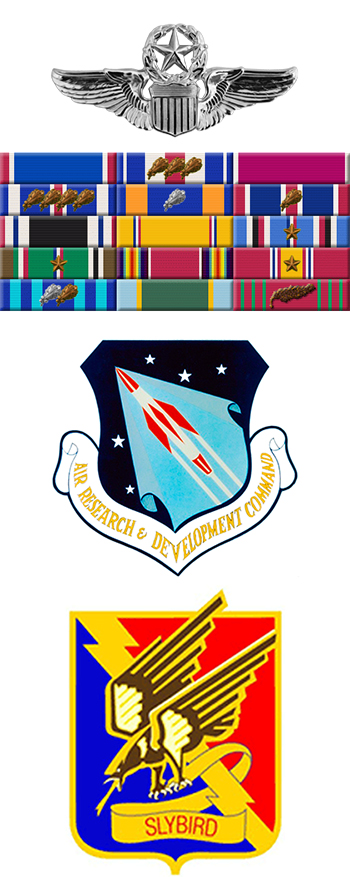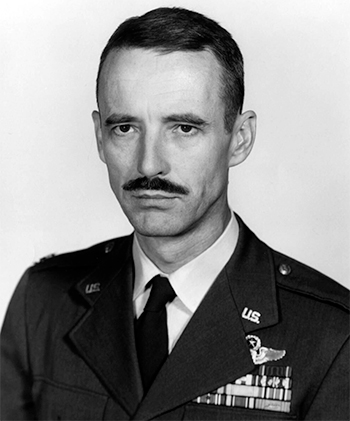
|
Walter C. "Walt" Beckham |
 |
|||
| Rank, Service | ||||
Colonel O-6, U.S. Air Force |
||||
| Veteran of: | ||||
|
||||
| Tribute: | ||||
Walt Beckham was born on May 12, 1916, in Paxton, Florida. He enlisted in the Aviation Cadet Program of the U.S. Army Air Corps on April 26, 1941, and was commissioned a 2d Lt in the U.S. Army Air Forces and awarded his pilot wings on December 12, 1941. His first assignment was as a P-36 Hawk pilot with XXVI Fighter Command at Albrook Field in the Panama Canal Zone before joining the 351st Fighter Squadron of the 353rd Fighter Group at Baltimore Army Airfield, Maryland, in early 1943. He transitioned to flying the P-40 Warhawk with the 351st Fighter Squadron in the United States, and then to the P-47 Thunderbolt when he deployed with his Squadron to England in June 1943. Major Beckham was credited with the destruction of 18 enemy aircraft in aerial combat with 2 probables, and 4 damaged in the air, before being shot down by flak and being forced to bail out of his stricken P-47 over Germany on February 22, 1944. He was immediately captured and taken as a Prisoner of War by the Germans, and was held at Stalag Luft III in Lower Silesia, Germany, and then at Stalag XIII-D and Stalag VII-A in Bavaria until his POW Camp was liberated by the American 14th Armored Division on April 29, 1945. At the time he was shot down, Major Beckham was the top-scoring American Fighter Ace in Europe, as well as being the Commander of the 351st Fighter Squadron. Lt Col Beckham remained in the Army Air Forces after he returned to the United States, and he served as a P-80 Shooting Star pilot and as Commander of the 71st Fighter Squadron of the 1st Fighter Group at March Field, California, from May to June 1947. He then received an assignment to complete his Bachelor's Degree in Physics from the University of Florida from 1947 to 1949, and then his Master's Degree in Physics from Ohio State University from 1949 to 1950. His next assignment was as Chief, Special Projects Branch with the Technical Analysis Division, Office for Atomic Energy, 1009th Special Weapons Squadron at Headquarters U.S. Air Force stationed at Bolling AFB, Maryland, from August 1950 to January 1951, and then as Chief of the Evaluation and Requirements Branch with the same unit from February 1951 to August 1952. Col Beckham then received an Air Force Institute of Technology Assignment to complete his PhD in Physics at the University of California, Berkeley, from August 1952 to June 1955, followed by service as Chief of the Munitions Branch, Strategic Air Division at Headquarters U.S. Air Force in the Pentagon from June 1955 to July 1958. Col Beckham served as Deputy Assistant to the Deputy Chief of Staff for Weapons Systems with Headquarters Air Research and Development Command (ARDC) at Andrews AFB, Maryland, from August 1958 to October 1959, and then as Assistant for Nuclear Programs with the Special Projects Division, Director of Research, Development, and Engineering with Headquarters ARDC at Andrews AFB from October 1959 to June 1960. His next assignment was as Director of Research and Development with the Air Force Special Weapons Command at Kirtland AFB, New Mexico, with Duty Station at the University of California Lawrence Radiation Lab in Livermore, California, from June 1960 to January 1962, followed by service as a Project Officer with the same unit from January 1962 to January 1963. Col Beckham's final assignment was as Chief Scientist at the Air Force Weapons Laboratory with Air Force Systems Command at Kirtland AFB from January 1963 until his retirement from the Air Force on July 1, 1969. After his retirement, Col Beckham continued as a consultant at Lawrence Livermore Laboratory for many years. Walt Beckham Flew West on May 31, 1996. |
||||
|
||||

